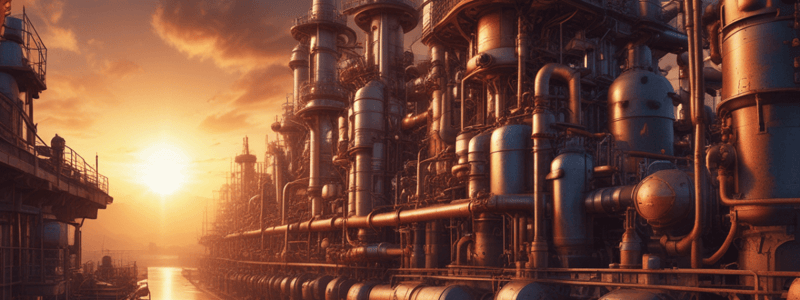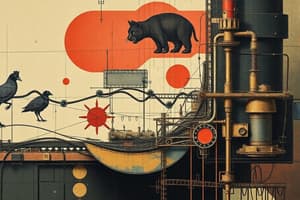Podcast
Questions and Answers
What is the primary difference between dry and wet corrosion?
What is the primary difference between dry and wet corrosion?
- Temperature
- Presence of oxygen
- Presence of moisture (correct)
- Type of metal
Which type of corrosion occurs when two dissimilar metals are in contact with each other?
Which type of corrosion occurs when two dissimilar metals are in contact with each other?
- Galvanic corrosion (correct)
- Inter-granular corrosion
- Pitting corrosion
- Waterline corrosion
What is the term for the process by which a more noble metal corrodes in preference to a less noble metal?
What is the term for the process by which a more noble metal corrodes in preference to a less noble metal?
- Galvanic corrosion
- Cathodic protection (correct)
- Pilling Bed worth rule
- Pitting corrosion
Which type of corrosion occurs along the grain boundaries of a metal?
Which type of corrosion occurs along the grain boundaries of a metal?
What is the rule that states that the corrosion rate of a metal is inversely proportional to its thickness?
What is the rule that states that the corrosion rate of a metal is inversely proportional to its thickness?
What is the primary mechanism of pitting corrosion?
What is the primary mechanism of pitting corrosion?
Which type of corrosion occurs when there is a difference in oxygen concentration between two areas?
Which type of corrosion occurs when there is a difference in oxygen concentration between two areas?
What is the purpose of the Pilling Bedworth rule?
What is the purpose of the Pilling Bedworth rule?
What is the primary difference between dry and wet corrosion in terms of the role of oxygen?
What is the primary difference between dry and wet corrosion in terms of the role of oxygen?
Which type of corrosion is more likely to occur in areas with high humidity?
Which type of corrosion is more likely to occur in areas with high humidity?
What is the primary mechanism of inter-granular corrosion?
What is the primary mechanism of inter-granular corrosion?
What is the primary reason for the formation of waterline corrosion?
What is the primary reason for the formation of waterline corrosion?
What is the primary application of the Pilling Bedworth rule?
What is the primary application of the Pilling Bedworth rule?
What is the primary factor that determines the severity of stress corrosion?
What is the primary factor that determines the severity of stress corrosion?
What is the primary difference between pitting corrosion and galvanic corrosion?
What is the primary difference between pitting corrosion and galvanic corrosion?
Flashcards are hidden until you start studying
Study Notes
Corrosion
- Definition: Deterioration of materials, usually metals, due to reaction with their environment
- Types of Corrosion:
- Dry Corrosion: Occurs in the absence of moisture, often due to chemical reactions
- Wet Corrosion: Occurs in the presence of moisture, leading to electrochemical reactions
Mechanism of Corrosion
- Involves oxidation of the metal surface, resulting in loss of electrons
- Counter reaction involves reduction of oxygen, resulting in gain of electrons
- Formation of corrosion cells, leading to corrosion reactions
Types of Corrosion
Pitting Corrosion
- Definition: Localized corrosion, forming small pits on the metal surface
- Causes: Presence of chlorides, sulfides, or other aggressive ions
Waterline Corrosion
- Definition: Corrosion occurring at the waterline or interface between water and air
- Causes: Concentration cells formed due to difference in oxygen levels
Inter-Granular Corrosion
- Definition: Corrosion occurring along grain boundaries in the metal
- Causes: Segregation of impurities or carbides along grain boundaries
Galvanic Corrosion
- Definition: Corrosion occurring when two dissimilar metals are in contact
- Causes: Electrochemical potential difference between the two metals
Stress Corrosion
- Definition: Corrosion accelerated by the presence of stress on the metal
- Causes: Combination of mechanical stress and corrosive environment
Pilling-Bedworth Rule
- Definition: States that a protective oxide film will form if the volume of oxide is less than the volume of metal consumed
- Application: Predicting the likelihood of a metal forming a protective oxide layer
Corrosion
- Definition: Deterioration of materials, usually metals, due to reaction with their environment
- Types of Corrosion:
- Dry Corrosion: Occurs in the absence of moisture, often due to chemical reactions
- Wet Corrosion: Occurs in the presence of moisture, leading to electrochemical reactions
Mechanism of Corrosion
- Involves oxidation of the metal surface, resulting in loss of electrons
- Counter reaction involves reduction of oxygen, resulting in gain of electrons
- Formation of corrosion cells, leading to corrosion reactions
Types of Corrosion
Pitting Corrosion
- Definition: Localized corrosion, forming small pits on the metal surface
- Causes: Presence of chlorides, sulfides, or other aggressive ions
Waterline Corrosion
- Definition: Corrosion occurring at the waterline or interface between water and air
- Causes: Concentration cells formed due to difference in oxygen levels
Inter-Granular Corrosion
- Definition: Corrosion occurring along grain boundaries in the metal
- Causes: Segregation of impurities or carbides along grain boundaries
Galvanic Corrosion
- Definition: Corrosion occurring when two dissimilar metals are in contact
- Causes: Electrochemical potential difference between the two metals
Stress Corrosion
- Definition: Corrosion accelerated by the presence of stress on the metal
- Causes: Combination of mechanical stress and corrosive environment
Pilling-Bedworth Rule
- Definition: States that a protective oxide film will form if the volume of oxide is less than the volume of metal consumed
- Application: Predicting the likelihood of a metal forming a protective oxide layer
Corrosion
- Definition: Deterioration of materials, usually metals, due to reaction with their environment
- Types of Corrosion:
- Dry Corrosion: Occurs in the absence of moisture, often due to chemical reactions
- Wet Corrosion: Occurs in the presence of moisture, leading to electrochemical reactions
Mechanism of Corrosion
- Involves oxidation of the metal surface, resulting in loss of electrons
- Counter reaction involves reduction of oxygen, resulting in gain of electrons
- Formation of corrosion cells, leading to corrosion reactions
Types of Corrosion
Pitting Corrosion
- Definition: Localized corrosion, forming small pits on the metal surface
- Causes: Presence of chlorides, sulfides, or other aggressive ions
Waterline Corrosion
- Definition: Corrosion occurring at the waterline or interface between water and air
- Causes: Concentration cells formed due to difference in oxygen levels
Inter-Granular Corrosion
- Definition: Corrosion occurring along grain boundaries in the metal
- Causes: Segregation of impurities or carbides along grain boundaries
Galvanic Corrosion
- Definition: Corrosion occurring when two dissimilar metals are in contact
- Causes: Electrochemical potential difference between the two metals
Stress Corrosion
- Definition: Corrosion accelerated by the presence of stress on the metal
- Causes: Combination of mechanical stress and corrosive environment
Pilling-Bedworth Rule
- Definition: States that a protective oxide film will form if the volume of oxide is less than the volume of metal consumed
- Application: Predicting the likelihood of a metal forming a protective oxide layer
Studying That Suits You
Use AI to generate personalized quizzes and flashcards to suit your learning preferences.




